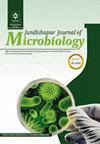从伊朗伊斯法罕临床样本中分离出的耐甲氧西林金黄色葡萄球菌的分子特征和噬菌体分型
IF 0.5
4区 医学
Q4 MICROBIOLOGY
引用次数: 0
摘要
背景:在医院和社区中,耐甲氧西林金黄色葡萄球菌(MRSA)由于能够获得对多种抗生素的耐药性,在疾病传播中扮演着重要角色。研究目的本研究旨在调查 MRSA 分离物的抗生素耐药性模式,并利用各种要素(包括 SCCmec 类型、ccr 类型、噬菌体类型和基因毒素图谱)对 MRSA 分离物进行分子分型。研究方法研究在伊斯法罕的扎赫拉医院进行,历时 20 个月,涉及来自不同解剖部位的 148 个分离株。对分离物的抗生素敏感性模式进行了评估。通过筛查 SCCmec 分型、ccr 分型、噬菌体分型以及 pvl、hlb、sak、eta 和 tst 毒素基因的 PCR 分析,对这些分离物进行鉴定。结果在总共 148 个金黄色葡萄球菌分离物中,42%(n = 62)具有耐甲氧西林性。MRSA分离株对青霉素和环丙沙星有很强的耐药性,90.3%的MRSA分离株具有多重耐药性。此外,在 45.16%、35.48% 和 19.35% 的 MRSA 分离物中分别发现了 SCCmec III、I 和 IV 型。此外,在 MRSA 分离物中还检测到 7 种噬菌体模式和 15 种毒素模式。结论:MRSA分离株普遍具有多重耐药性。在所调查的抗生素中,唯一有效的药物是氯霉素。可通过改变抗生素处方程序和应用感染控制策略来控制 MRSA 分离物。所研究的 MRSA 分离物由于含有多种编码毒力因子的噬菌体,可导致多种疾病。鉴定不同类型的噬菌体可能有助于预测此类致病因子。本文章由计算机程序翻译,如有差异,请以英文原文为准。
Molecular Characterization and Phage Typing of Methicillin-resistant Staphylococcus aureus Isolated from Clinical Samples in Isfahan, Iran
Background: In hospitals and communities, Methicillin-resistant Staphylococcus aureus (MRSA) plays a critical role due to its ability to acquire resistance against several antibiotics and play a role in the spread of diseases. Objectives: This research aimed to investigate the pattern of antibiotic resistance in MRSA isolates and perform molecular typing of MRSA isolates using various elements, including SCCmec type, ccr type, prophage type, and gene toxin profiles. Methods: The research spanned 20 months at Al-Zahra Hospital in Isfahan and involved 148 isolates from various anatomical sites. The isolates were evaluated for their antibiotic susceptibility patterns. They were characterized by screening for SCCmec typing, ccr typing, phage typing, and PCR profiling of pvl, hlb, sak, eta, and tst toxin genes. Results: From 148 total S. aureus isolates, 42% (n = 62) were methicillin-resistant. The MRSA isolates demonstrated substantial resistance to penicillin and ciprofloxacin, and 90.3% of MRSA isolates were multiple-drug resistant. Also, SCCmec types III, I, and IV were identified in 45.16%, 35.48%, and 19.35% of MRSA isolates, respectively. Also, seven prophage patterns and 15 toxin patterns were detected among MRSA isolates. Conclusions: Multi-drug resistance is common among MRSA isolates. The only effective drug among the investigated antibiotics was chloramphenicol. The MRSA isolates can be controlled by changing the prescribing procedure of antibiotics and applying infection control strategies. The studied MRSA isolates can cause a wide range of diseases due to having several bacteriophages that encode virulence factors. Identification of different types of prophages may be useful in predicting such pathogenic agents.
求助全文
通过发布文献求助,成功后即可免费获取论文全文。
去求助
来源期刊

Jundishapur Journal of Microbiology
MICROBIOLOGY-
CiteScore
1.30
自引率
0.00%
发文量
56
审稿时长
6-12 weeks
期刊介绍:
Jundishapur Journal of Microbiology, (JJM) is the official scientific Monthly publication of Ahvaz Jundishapur University of Medical Sciences. JJM is dedicated to the publication of manuscripts on topics concerning all aspects of microbiology. The topics include medical, veterinary and environmental microbiology, molecular investigations and infectious diseases. Aspects of immunology and epidemiology of infectious diseases are also considered.
 求助内容:
求助内容: 应助结果提醒方式:
应助结果提醒方式:


